We woke up early in the morning, had a simple breakfast before we set off for the second day in Beijing, starting with Tiananmen Square. We took the MRT from Beixingqiao Station (北新桥) to Tiananmen East Station (天安门东). The security at the entrance to the Square is tight. The authorities would even check the papers I had in my bag, probably to make sure we don't bring anything into the Square to protest. The square is very big, one of the largest city square in the world, and is flanked by many important icons, such as the Tiananmen Gate (天安门) (which the square is named after), Monument to the People's Heroes (人民英雄纪念碑), Mausoleum of Mao Zedong (毛主席纪念堂), National Museum of China (中国国家博物馆) and The Great Hall of the People (人民大会堂). There's nothing much to do here, other than taking photos against different backdrops and to view the Flag Raising Ceremony (which I did not attend, because it happens very early in the morning). We spent half an hour here strolling around and taking photos, before we head to the Forbidden City through the Tiananmen Gate (天安门).
 |
| Tiananmen Square - Tiananmen Gate at background |
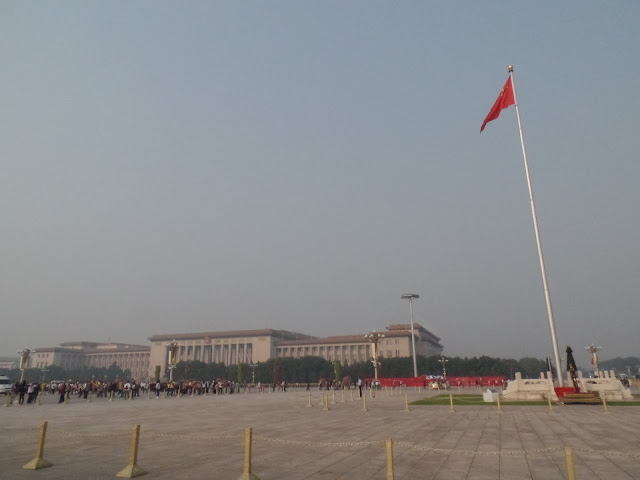 |
| Tiananmen Square |
The Forbidden City, now known as the Palace Museum (故宫博物院), is the former imperial palace for the 24 emperors of the Ming and Qing dynasty. Along with the Tiananmen Square, it is considered as the must-visit attraction in Beijing. The entire palace is huge and comprises of numerous halls of different sizes for different purposes, such as residence, ceremonies, state meetings etc. The area can be divided into the Central Axis, East Wing and West Wing. Tourists can only enter the palace via the south (from the Meridian Gate 午门) and exit from the north Gate of Divine Prowess (神武门), located along the Central Axis. From the Tiananmen Gate (天安门), we walked north and just before the Meridian Gate (午门), we reached the ticket office area to buy the entrance tickets. After the security check in front of the Meridian Gate (午门), we entered the palace proper.
 |
| Forbidden City entrance ticket |
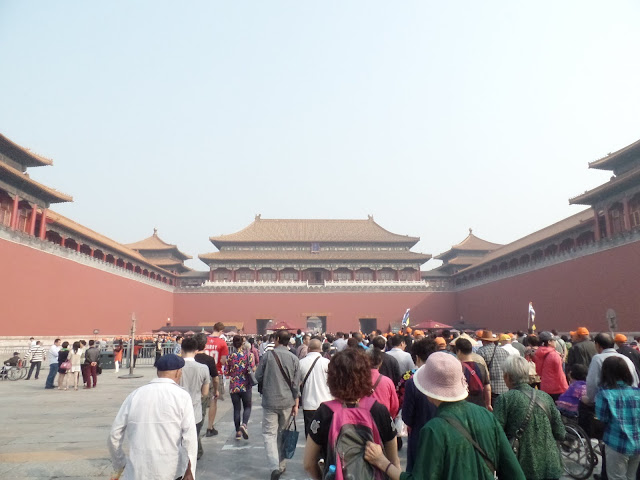 |
| Meridian Gate |
The first place that greeted us was the Taihemen Square (太和门广场). We could see a small river with 5 bridges across, which are known as the Inner Golden River Bridges (内金水桥). In the past, the central bridge was used exclusively by the emperor only. At the background is the Gate of Supreme Harmony (太和门), which leads to the Taihedian Square (太和殿广场).
 |
| Taihemen Square - Inner Golden River Bridges |
The Taihedian Square (太和殿广场) is the largest square within the palace, where 3 grand halls are located, Hall of Supreme Harmony (太和殿), Hall of Middle Harmony (中和殿) and Hall of Preserving Harmony (保和殿). Together, they form the Outer Court area. The Hall of Supreme Harmony (太和殿) stands majestically on a three tier marble terrace and is also the largest and tallest building in the palace. Inside the hall (which is out of bound for tourists), we could see the emperor's throne, along with the exquisite carvings and decorations on the pillars and roof. This is the place where the emperor received high rank officials and host important ceremonies.
 |
| Hall of Supreme Harmony |
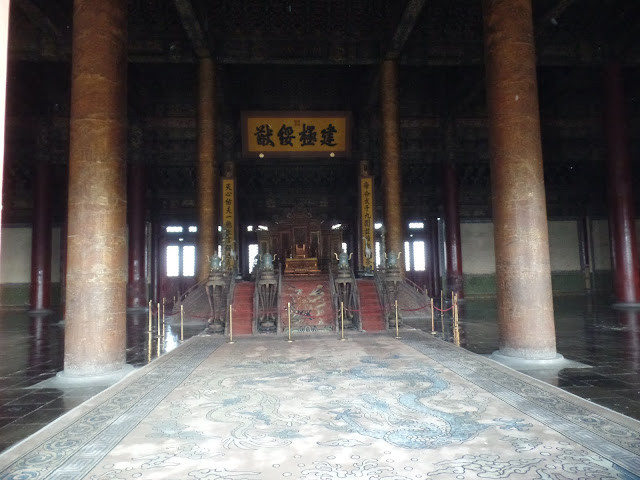 |
| Interior of Hall of Supreme Harmony |
The other 2 halls are smaller, but equally majestic as well.
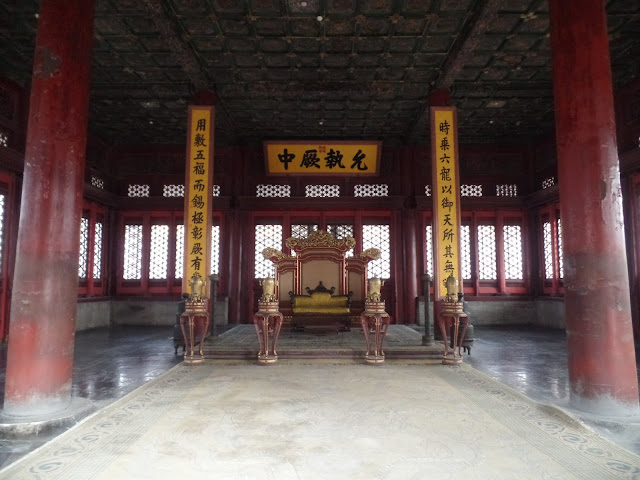 |
| Interior of Hall of Middle Harmony |
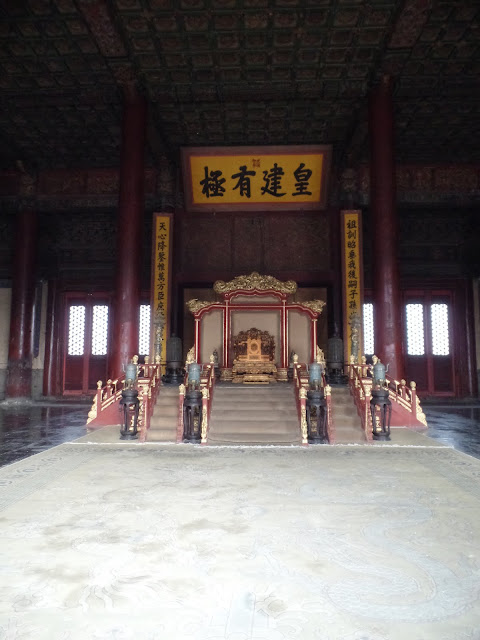 |
| Interior of Hall of Preserving Harmony |
After this area, we walked to the East Wing where there are 2 galleries, Treasure Gallery and the Clock and Watch Gallery, which required separate entrance tickets. We decided to give them a miss and rested near the souvenir shops around the Gate of Heavenly Purity (乾清门).
We then entered the Inner Court via the Gate of Heavenly Purity (乾清门) and where there are 3 more halls. The Palace of Heaven Purity (乾清宫) was the residence of the emperors until Qing Emperor Yongzheng when he shifted his residence to the Hall of Mental Cultivation (养心殿).
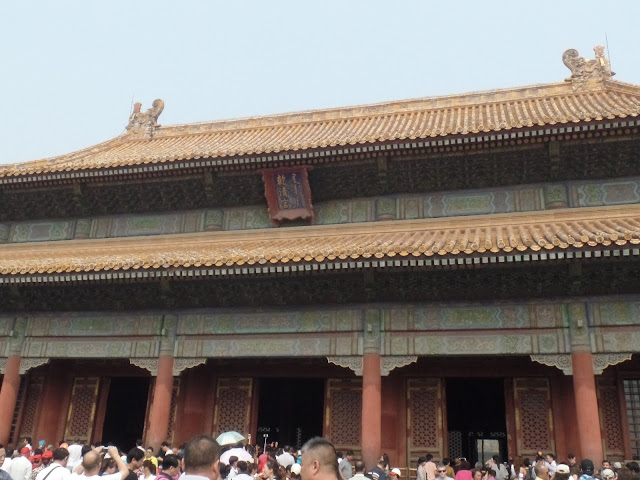 |
| Palace of Heaven Purity |
 |
| Palace of Heaven Purity Intro |
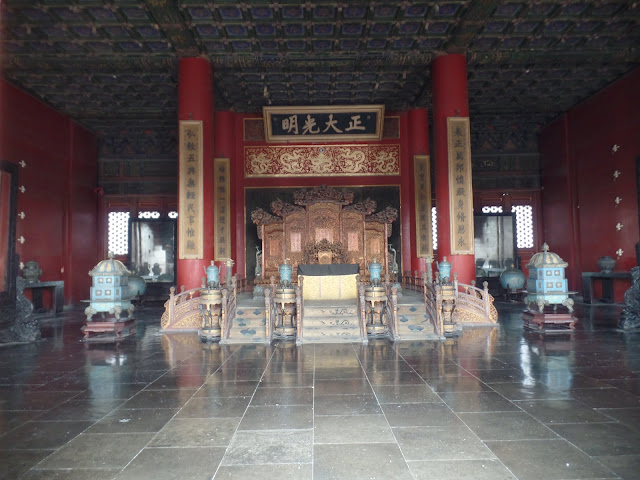 |
| Interior of Palace of Heaven Purity |
Behind it is the Hall of Union and Peace (交泰殿), which served as a storage place for the treasures and ceremonial items.
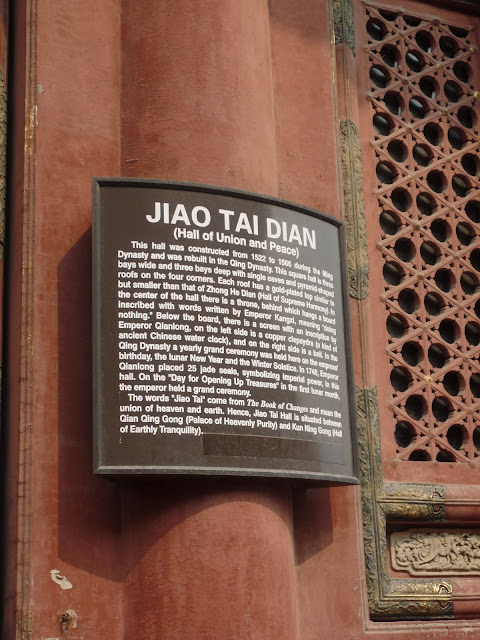 |
| Hall of Union and Peace Intro |
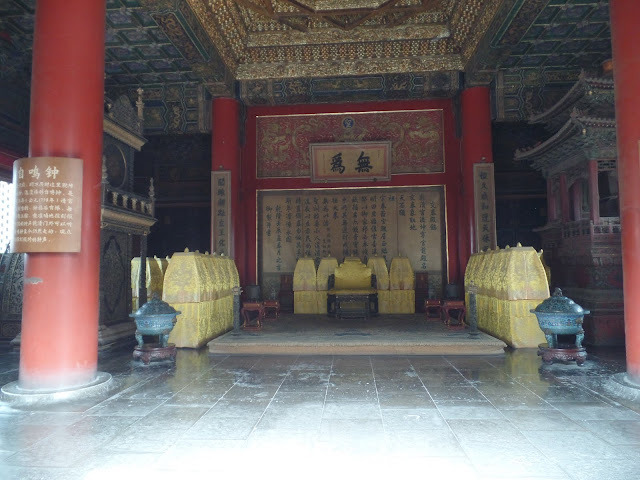 |
| Interior of Hall of Union and Peace |
Lastly the Palace of Earth Tranquility (坤宁宫), which served as the empress residence during the Ming dynasty and then as nuptial chamber during the Qing dynasty.
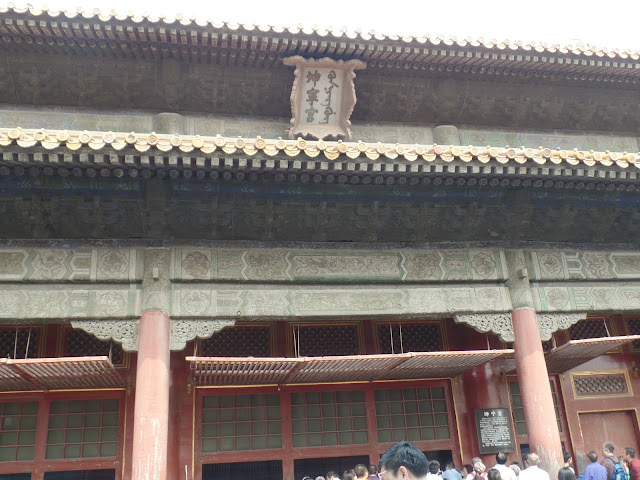 |
| Palace of Earth Tranquility |
After this, we walked to the East Wing again. Over here, several halls were converted to house the Bronze Gallery, and we could also see the 6 Eastern Palaces. After completing the East Wing, we went over to the West Wing. The most notable hall over here is the Hall of Mental Cultivation (养心殿). This was the residence for all the Qing emperors from Emperor Yongzheng (雍正皇帝) onward. On the east chamber, one could see the famous place where the 2 Empress Dowagers Ci'xi and Ci'an (慈禧 慈安太后) used to rule the court behind the curtain, during Emperor Tongzhi's (同治皇帝) era.
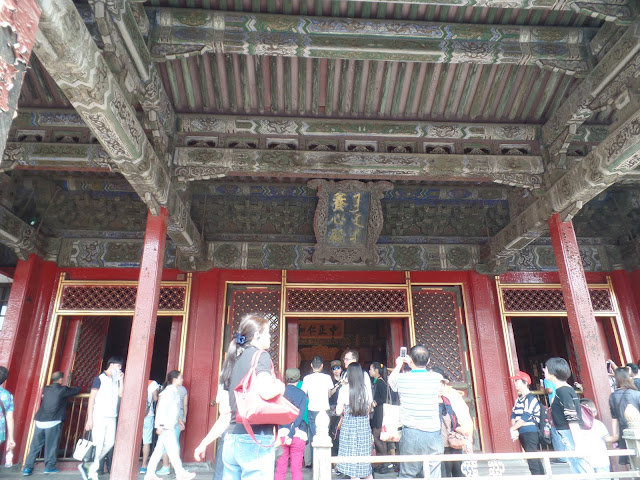 |
| Hall of Mental Cultivation |
 |
| Hall of Mental Cultivation Intro |
 |
| Interior of Hall of Mental Cultivation |
 |
| Hall of Mental Cultivation - Place where the 2 Empress Dowager reign |
At the West Wing, we could also see the 6 Western Palaces. The famous one includes the Palace of Gathered Elegance (储秀宫), which was the former residence of Empress Dowager Ci'xi (慈禧太后).
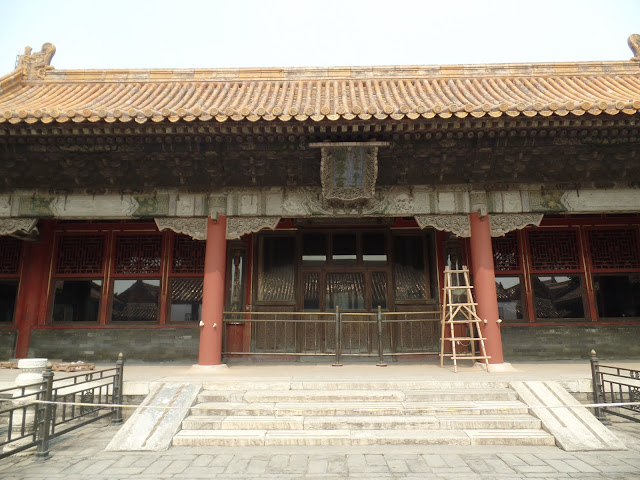 |
| Palace of Gathered Elegance |
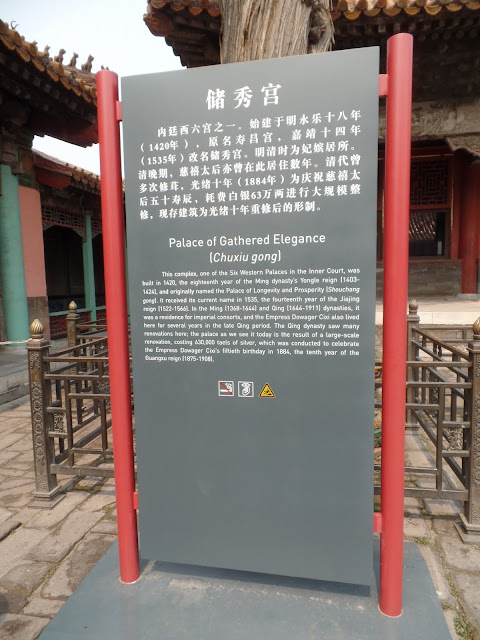 |
| Palace of Gathered Elegance Intro |
We visited the last area in the palace, which is the imperial garden. The garden itself is not very big and we did not stay long and eventually exited the palace via the Gate of Divine Prowess (神武门) at the rear. In total, we had spent around 4 hours in the palace.
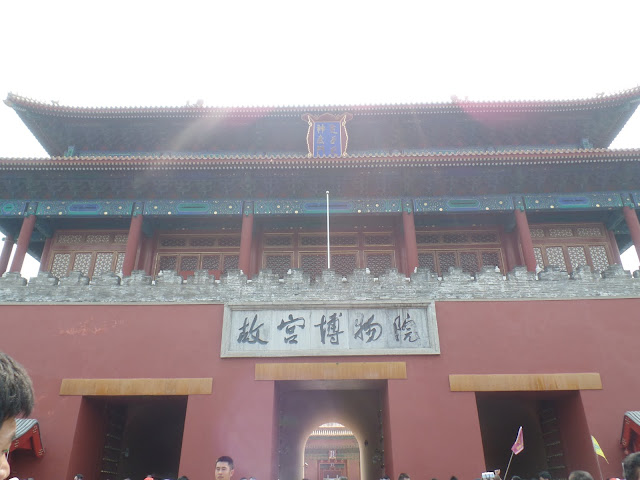 |
| Gate of Divine Prowess |
Out of the palace, it was not a convenient place to travel to other sites. We had a long walk to Xisi Station (西四) and had lunch along one of the restaurant specialized on Jiangnan noodles.
Old Summer Palace (圆明园)
We took the MRT to the Yuanmingyuan Park Station (圆明园). The station is located at the south entrance of the Old Summer Palace (圆明园). We bought our tickets here and entered the park.
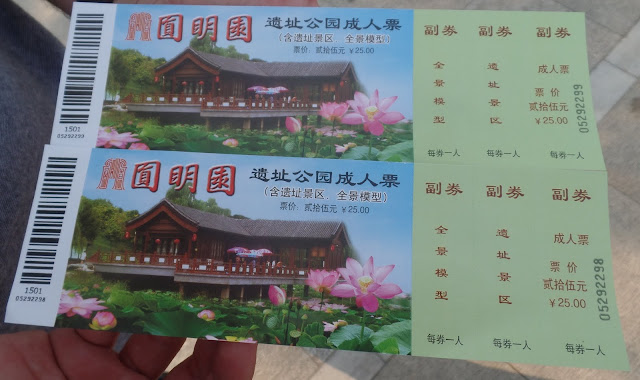 |
| Old Summer Palace entrance ticket |
The whole area is made of 3 gardens, Garden of Perfect Brightness (圆明园), Garden of Eternal Spring (长春园) and Elegant Spring Garden (绮春园), which combined is around 5 times the size of the Forbidden City! During its glorious days, it was hailed as the "Garden of Gardens" for its extensive gardens and architectural buildings. Its fortune suffered a tragic end when it was destroyed by the British-French forces during Second Opium War. The park we see now is never restored to its former glorious days and ruins can still be seen today. The south entrance is located in the Elegant Spring Garden (绮春园) and we started our tour here. Walking along, we could see reconstructed pavilions, bridges, rivers, ponds and flowers etc.
 |
| Lake near the entrance |
 |
| Ruined Stone Arch Bridge |
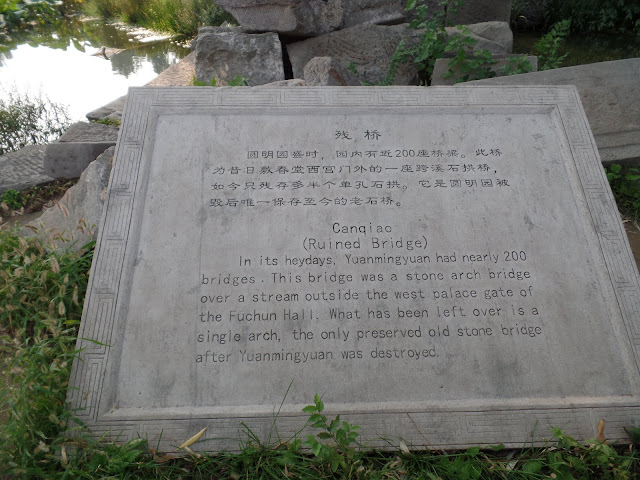 |
| Ruined Arch Bridge Intro |
Tourists could board the boats and travel to other sites within the park through the lakes and waterways. At the intersection between the Garden of Eternal Spring (长春园) and Elegant Spring Garden (绮春园), there's an exhibition about the 12 zodiac animal bronze head. It is an exhibition about the destruction of the palace and the looting of the 12 bronze heads that were once part of the Haiyantang (海晏堂) located in the Western Mansions (西洋楼) section. Jackie Chan's movie CZ12 (十二生肖) is loosely based on this theme. In the exhibition, we could see the replica of the 12 bronze heads. From there, we also learnt that 7 of the bronze heads were already returned to China, while the other 5 remained missing to date.
 |
| Haiyantang Exhibition |
 |
| Replica of the Dragon Bronze Head |
We walked further north and reached the Western Mansions (西洋楼) section, which is located at the northern end of the Garden of Eternal Spring (长春园). The Western Mansions (西洋楼) section is the most popular attraction within the Old Summer Palace (圆明园), because this is where most of the ruins of the stone buildings still remains. The place got its name because this area used to be occupied with European style architectural buildings, pavilions and fountains. We entered the section from the west and exit on the east end.
 |
| Introduction to the Western Mansions area |
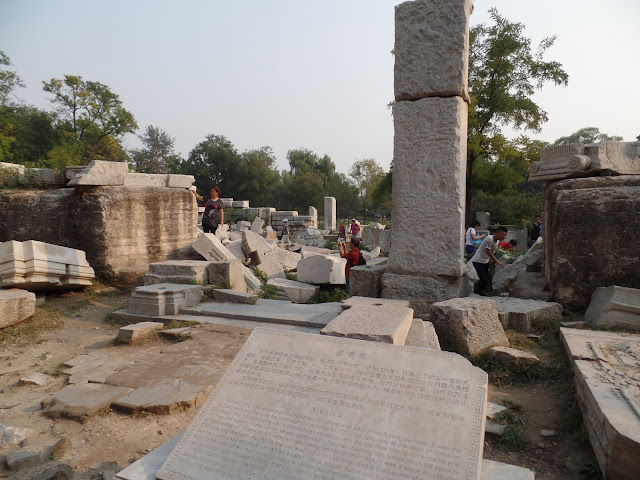 |
| Ruins of Xieqiqu |
 |
| Huanghuazhen |
 |
| Huanghuazhen Intro |
 |
| Replicas of the 12 Chinese Zodiac Animals at Haiyantang |
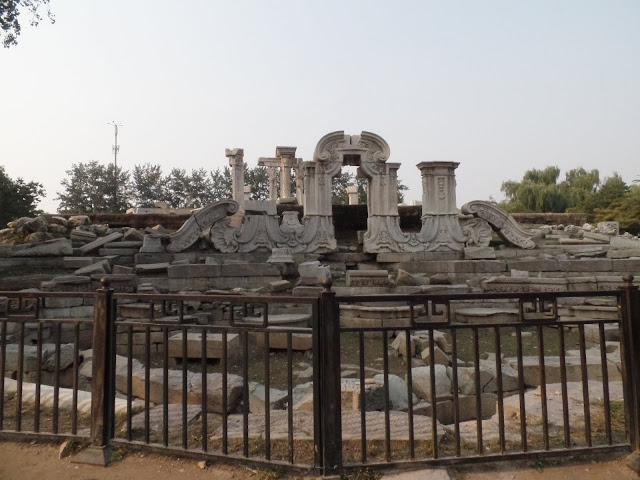 |
| Ruins of Dashuifa |
After the tour here, we decided to make our back to the south entrance. We had no more energy or time to explore the other Garden of Perfect Brightness (圆明园). Walking south, we reached another exhibition called the Heyday Panorama Model, which shows a miniature panorama view of the entire palace before its destruction. I was astonished by the scale of the entire palace, numerous Chinese style architectural buildings and bridges that once stood were no longer seen in the park now. We could also see the original looks of the Western Mansions (西洋楼) from the model.
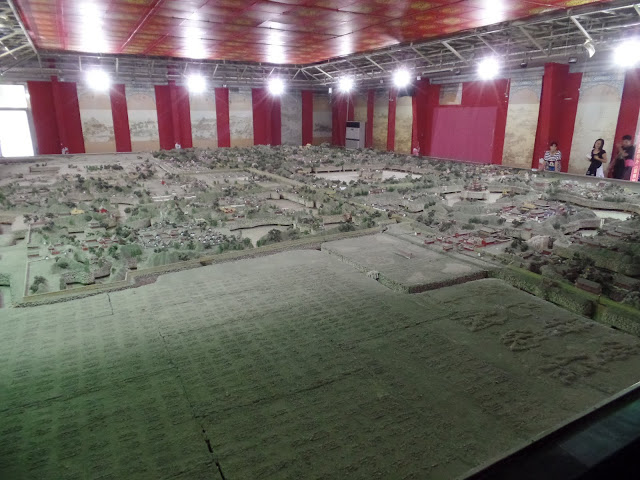 |
| Old Summer Palace Heyday Panorama Model |
 |
| Zoom in on the models |
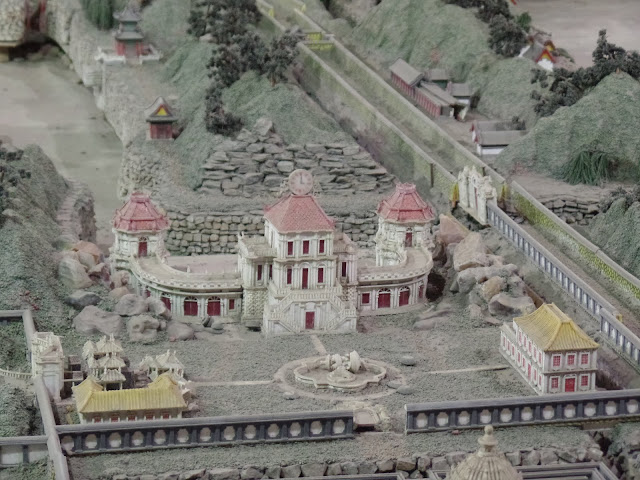 |
| Model of Xieqiqu |
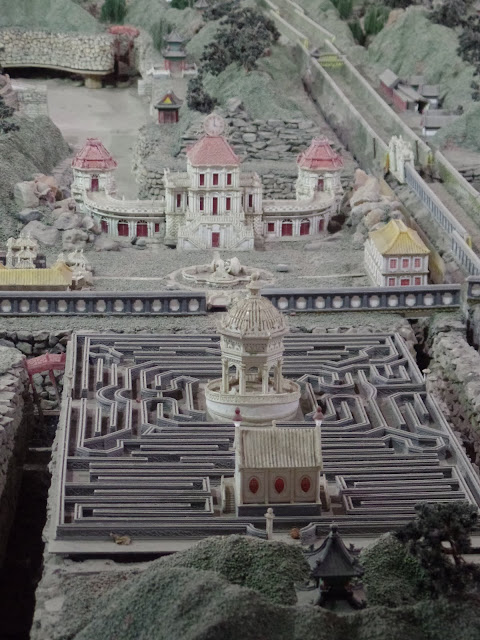 |
| Model of Huanghuazhen |
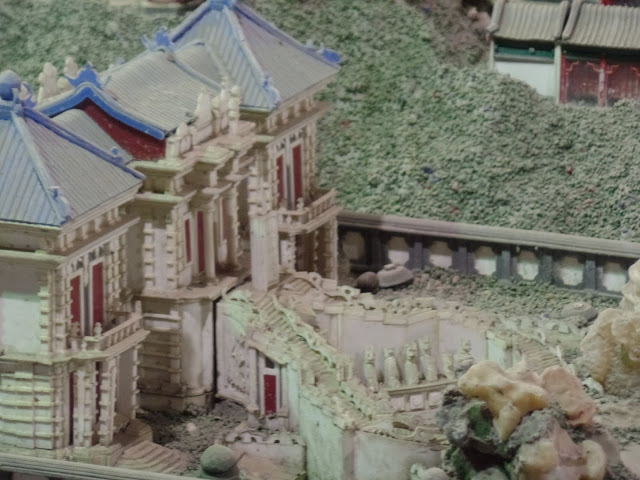 |
| Model of Haiyantang |
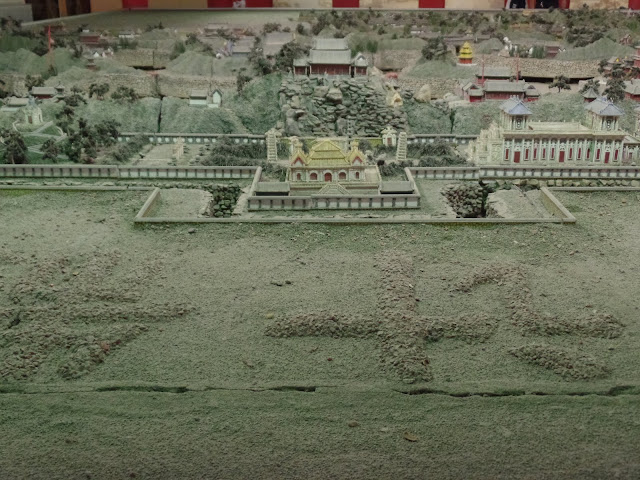 |
| Model of Yuanyingguan in the center. Haiyantang is on the right. |
We eventually exited the park from the south entrance where we originally came from. From there, we took the MRT to Wangfujing Station (王府井).
Wangfujing (王府井)
By the time we reached Wangfujing Station (王府井), it was already evening and its time for dinner. Wangfujing (王府井) is a very popular shopping area in Beijing. It comprises of several streets and flanked by large shopping malls, hotels, shops, cafe and restaurants. On the west side of the main street, there's a snack street that sells all sort of food and snacks from different parts of China.
 |
| Wangfujing Street |
The street snacks here did not interest us and eventually we went to a restaurant in one of the mall (I cannot recall which mall was it). After dinner, we visited the New China Children Store (新中国儿童用品商店), which is a 6 level mall selling all kinds of children merchandise. Back to the main street, we also bought matcha from a tea shop. After this, it was getting late and we headed back to our hotel to call it a day.









































No comments:
Post a Comment